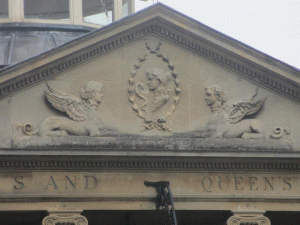Above the ‘King’s and Queen’s Bath I found them. A pair of sphinxes in the tympan: two females lay flat on the belly with upraised wings and a poshly curled tail. These features reveal its 18th century origin (in this case the Georgian era: 1714–1837), in which the mythical creature evoked ancient times, in this case the Roman era.
In facing each other, they flank a medallion of a female bust that can be identified as Hygieia due to the cup and the snake in front of her. As the daughter of Asklepios, god of medicine, and Epione, goddess of health, she was goddess of good health, recognizable in her feeding the snake (aesculap) from a cup
Her function makes sense, since in the Georgian era the curative effect of hot springs were hailed: in addition to bathing in the healing hot springs, many people drank the water.
Literature:

